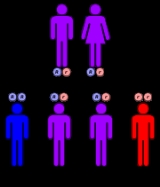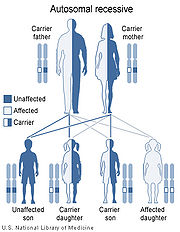
Rothmund-Thomson syndrome
Encyclopedia
Rothmund–Thomson syndrome (RTS), also known as poikiloderma atrophicans with cataract or poikiloderma congenitale, is a rare autosomal
recessive skin condition originally described by August von Rothmund
(1830–1906) in 1868. Matthew Sydney Thomson (1894–1969) published further descriptions in 1936.
There have been several reported cases associated with osteosarcoma
. A hereditary genetic
basis, mutations in the DNA
Helicase
RECQL4
gene, has been implicated in the syndrome.
The skin is normal at birth. Between 3 to 6 moths of age, the affected carrier develops poikiloderma on the cheeks. This characteristic “rash” that all RTS carriers have can develop on the arms, legs and buttocks. “Poikiloderma consists of areas of increased ans decreased pigmentation, prominent blood vessels, and thinning of the skin”
 RTS is caused by a mutation of the RECQL4
RTS is caused by a mutation of the RECQL4
gene, located at chromosome
8q24.3
. The disorder is inherited in an autosomal recessive manner. This means the defective gene responsible for the disorder is located on an autosome
(chromosome 8 is an autosome), and two copies of the defective gene (one inherited from each parent) are required in order to be born with the disorder. The parents of an individual with an autosomal recessive disorder both carry
one copy of the defective gene, but usually do not experience any signs or symptoms of the disorder.
Autosome
An autosome is a chromosome that is not a sex chromosome, or allosome; that is to say, there is an equal number of copies of the chromosome in males and females. For example, in humans, there are 22 pairs of autosomes. In addition to autosomes, there are sex chromosomes, to be specific: X and Y...
recessive skin condition originally described by August von Rothmund
August von Rothmund
August von Rothmund was a German ophthalmologist from Volkach, Lower Franconia. In 1853 he received his doctorate from the University of Munich, and furthered his studies in Berlin under Albrecht von Graefe ; in Prague with Carl Ferdinand von Arlt and in Vienna with Eduard Jäger von Jaxtthal...
(1830–1906) in 1868. Matthew Sydney Thomson (1894–1969) published further descriptions in 1936.
There have been several reported cases associated with osteosarcoma
Osteosarcoma
Osteosarcoma is an aggressive cancerous neoplasm arising from primitive transformed cells of mesenchymal origin that exhibit osteoblastic differentiation and produce malignant osteoid...
. A hereditary genetic
Genetics
Genetics , a discipline of biology, is the science of genes, heredity, and variation in living organisms....
basis, mutations in the DNA
DNA
Deoxyribonucleic acid is a nucleic acid that contains the genetic instructions used in the development and functioning of all known living organisms . The DNA segments that carry this genetic information are called genes, but other DNA sequences have structural purposes, or are involved in...
Helicase
Helicase
Helicases are a class of enzymes vital to all living organisms. They are motor proteins that move directionally along a nucleic acid phosphodiester backbone, separating two annealed nucleic acid strands using energy derived from ATP hydrolysis.-Function:Many cellular processes Helicases are a...
RECQL4
RECQL4
ATP-dependent DNA helicase Q4 is an enzyme that in humans is encoded by the RECQL4 gene.Mutations in RECQL4 are associated with the autosomal recessive disease Rothmund-Thomson Syndrome. There are two types of Rothmund Thomson syndrome and it is Type 2 that is caused by patients carrying...
gene, has been implicated in the syndrome.
Characteristics
- Sun-sensitive rash with prominent poikilodermaPoikilodermaPoikiloderma is a skin condition that "consists of areas of increased and decreased pigmentation, prominent blood vessels, and thinning of the skin."...
and telangiectasias - Juvenile cataracts
- Saddle nose
- Congenital bone defects, including short stature and radial ray anomalies such as absent thumbs
- Hair growth problems (absent eyelashes, eyebrows and/or hair)
- HypogonadismHypogonadismHypogonadism is a medical term for decreased functional activity of the gonads. Low testosterone is caused by a decline or deficiency in gonadal production of testosterone in males...
has not been well documented - Hypodontia
- Calcium problems (not documented in journals)
- Ear problems (not documented in journals but identified by patients in support groups)
- OsteosarcomaOsteosarcomaOsteosarcoma is an aggressive cancerous neoplasm arising from primitive transformed cells of mesenchymal origin that exhibit osteoblastic differentiation and produce malignant osteoid...
The skin is normal at birth. Between 3 to 6 moths of age, the affected carrier develops poikiloderma on the cheeks. This characteristic “rash” that all RTS carriers have can develop on the arms, legs and buttocks. “Poikiloderma consists of areas of increased ans decreased pigmentation, prominent blood vessels, and thinning of the skin”
Cause and Genetics

RECQL4
ATP-dependent DNA helicase Q4 is an enzyme that in humans is encoded by the RECQL4 gene.Mutations in RECQL4 are associated with the autosomal recessive disease Rothmund-Thomson Syndrome. There are two types of Rothmund Thomson syndrome and it is Type 2 that is caused by patients carrying...
gene, located at chromosome
Chromosome
A chromosome is an organized structure of DNA and protein found in cells. It is a single piece of coiled DNA containing many genes, regulatory elements and other nucleotide sequences. Chromosomes also contain DNA-bound proteins, which serve to package the DNA and control its functions.Chromosomes...
8q24.3
Chromosome 8 (human)
Chromosome 8 is one of the 23 pairs of chromosomes in humans. People normally have two copies of this chromosome. Chromosome 8 spans about 145 million base pairs and represents between 4.5 and 5.0% of the total DNA in cells....
. The disorder is inherited in an autosomal recessive manner. This means the defective gene responsible for the disorder is located on an autosome
Autosome
An autosome is a chromosome that is not a sex chromosome, or allosome; that is to say, there is an equal number of copies of the chromosome in males and females. For example, in humans, there are 22 pairs of autosomes. In addition to autosomes, there are sex chromosomes, to be specific: X and Y...
(chromosome 8 is an autosome), and two copies of the defective gene (one inherited from each parent) are required in order to be born with the disorder. The parents of an individual with an autosomal recessive disorder both carry
Genetic carrier
A genetic carrier , is a person or other organism that has inherited a genetic trait or mutation, but who does not display that trait or show symptoms of the disease. They are, however, able to pass the gene onto their offspring, who may then express the gene...
one copy of the defective gene, but usually do not experience any signs or symptoms of the disorder.

